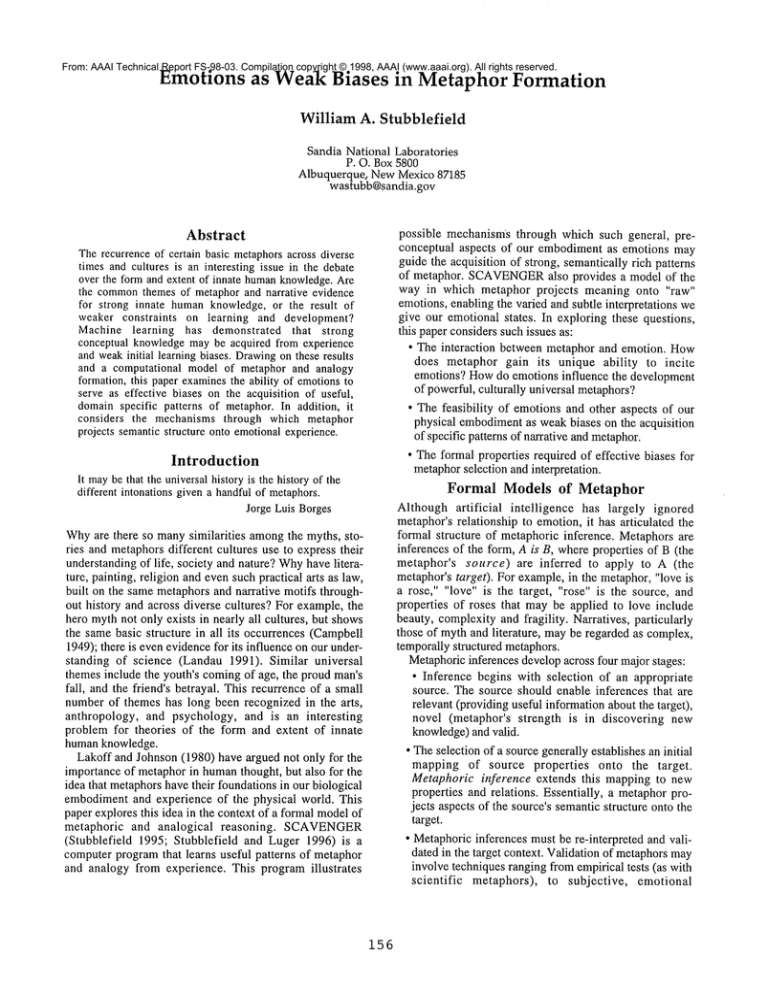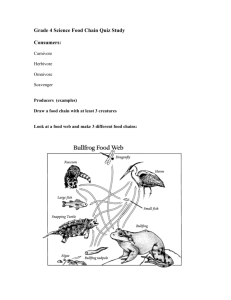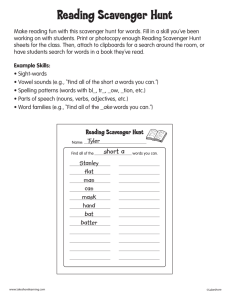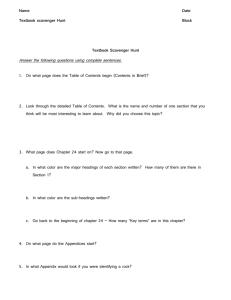
From: AAAI Technical Report FS-98-03. Compilation copyright © 1998, AAAI (www.aaai.org). All rights reserved.
Emotions as Weak Biases
in Metaphor Formation
William A. Stubblefield
Sandia National Laboratories
P. O. Box5800
Albuquerque, NewMexico 87185
wastubb@sandia.gov
possible mechanisms through which such general, preconceptual aspects of our embodimentas emotions may
guide the acquisition of strong, semantically rich patterns
of metaphor. SCAVENGER
also provides a model of the
way in which metaphor projects meaning onto "raw"
emotions, enabling the varied and subtle interpretations we
give our emotional states. In exploring these questions,
this paper considers such issues as:
¯ The interaction between metaphor and emotion. How
does metaphor gain its unique ability to incite
emotions? Howdo emotions influence the development
of powerful, culturally universal metaphors?
¯ The feasibility of emotions and other aspects of our
physical embodimentas weakbiases on the acquisition
of specific patterns of narrative and metaphor.
¯ The formal properties required of effective biases for
metaphorselection and interpretation.
Abstract
The recurrence of certain basic metaphorsacross diverse
times and cultures is an interesting issue in the debate
over the form and extent of innate humanknowledge.Are
the commonthemes of metaphor and narrative evidence
for strong innate humanknowledge, or the result of
weaker constraints on learning and development?
Machine learning has demonstrated that strong
conceptual knowledgemaybe acquired from experience
and weakinitial learning biases. Drawingon these results
and a computational model of metaphor and analogy
formation,this paper examinesthe ability of emotionsto
serve as effective biases on the acquisition of useful,
domainspecific patterns of metaphor. In addition, it
considers the mechanisms through which metaphor
projects semanticstructure onto emotionalexperience.
Introduction
It maybe that the universal history is the history of the
different intonations given a handful of metaphors.
Jorge Luis Borges
Formal Models of Metaphor
Whyare there so manysimilarities amongthe myths, stories and metaphorsdifferent cultures use to express their
understanding of life, society and nature? Whyhave literature, painting, religion and even such practical arts as law,
built on the same metaphors and narrative motifs throughout history and across diverse cultures? For example, the
hero mythnot only exists in nearly all cultures, but shows
the same basic structure in all its occurrences (Campbell
1949); there is evenevidencefor its influence on our understanding of science (Landau 1991). Similar universal
themes include the youth’s comingof age, the proud man’s
fall, and the friend’s betrayal. This recurrence of a small
number of themes has long been recognized in the arts,
anthropology, and psychology, and is an interesting
problem for theories of the form and extent of innate
human knowledge.
Lakoff and Johnson (1980) have argued not only for the
importance of metaphorin humanthought, but also for the
idea that metaphorshave their foundations in our biological
embodimentand experience of the physical world. This
paper explores this idea in the context of a formal modelof
metaphoric and analogical
reasoning.
SCAVENGER
(Stubblefield 1995; Stubblefield and Luger 1996) is
computerprogramthat learns useful patterns of metaphor
and analogy from experience. This program illustrates
156
Although artificial
intelligence has largely ignored
metaphor’s relationship to emotion, it has articulated the
formal structure of metaphoric inference. Metaphorsare
inferences of the form, A is B, where properties of B (the
metaphor’s source) are inferred to apply to A (the
metaphor’starget). For example, in the metaphor, "love is
a rose," "love" is the target, "rose" is the source, and
properties of roses that may be applied to love include
beauty, complexityand fragility. Narratives, particularly
those of myth and literature, maybe regarded as complex,
temporally structured metaphors.
Metaphoricinferences develop across four major stages:
¯ Inference begins with selection of an appropriate
source. The source should enable inferences that are
relevant (providing useful informationabout the target),
novel (metaphor’s strength is in discovering new
knowledge)and valid.
¯ Theselection of a source generally establishes an initial
mapping of source properties
onto the target.
Metaphoric inference extends this mapping to new
properties and relations. Essentially, a metaphorprojects aspects of the source’s semantic structure onto the
target.
¯ Metaphoricinferences must be re-interpreted and validated in the target context. Validation of metaphorsmay
involve techniques ranging from empirical tests (as with
scientific
metaphors), to subjective, emotional
responses to artistic metaphors. Interpretation and
validation are closely coupled, with validation failures
often leading to re-interpretation (or repair) of the
metaphor.
¯ Finally, participants in the metaphorshould learn. The
metaphor should not only change our understanding of
the target, but also should improveour ability to apply
the samemetaphoricsource in the future.
This frameworkis, of course, an abstraction from much
more complex and still poorly understood processes.
Although alternative models (most notably Black’s (1962)
interaction
theory) exist, this simple framework
characterizes the major decisions that must be made in
developing any metaphor or narrative. For example, in
writing a story, an author must:
¯ Determine its basic form: is the story a comedy?a
tragedy? a tale of a hero’s struggles? This is the choice
of a metaphoric source. For example, an author may
decide that her intention can best be communicated
using a "moral agent as embattled hero" metaphor.
¯ Compose
the story through a process of interpreting the
basic metaphorand projecting this interpretation onto
the story’s target theme: Is the hero’s struggle a war? a
criminal investigation? a journey? Howdoes the author
flesh out the basic narrative framework?Whatare the
major traits of the heroes and villains? What are the
consequencesof their moral choices?
¯ Interpret and validate the metaphoracross different
revisions and through the editing process. Whenthe
story is published, processes of criticism and discussion
contribute to the metaphor’songoingre-interpretation.
¯ Learn from the metaphor, from its developmentacross
different articulations, interpretations and contexts. This
involves both the author and her audience.
Metaphoric inference is complex and could not be
performed without somesort of heuristic bias. Following
standard artificial
intelligence terminology, we may
characterize heuristics as either "strong" or "weak":
Strong heuristics involve knowledge of a particular
problem domain. An example of a strong heuristic for
metaphor formation might be the knowledge that "waves
are often a useful metaphorfor explaining cyclical natural
phenomena."Similarly, the general form of the hero story
is a strong heuristic for constructing narratives: cultures
often express their key values through stories of a hero’s
personal struggles to preserve "good"and overcome"evil."
The cognitive science literature supports the role of
strong heuristics in metaphor and analogy. For example,
Holyoak (1985) has demonstrated that humansubjects are
better able to interpret a suggested analogy once they have
been showna structurally similar analogy. In this case, the
example provides strong clues to the structure of the
suggested analogy.
In contrast, weakheuristics exploit only general, formal
properties of the target or source. Systematicity, the ability
of a single metaphor to project an entire system of
157
properties and relations onto the target (Black 1962;
Gentner 1983; Lakoff and Johnson 1980), is the basis of
manysuch heuristics. For example, the structure-mapping
theory of analogy favors source-target mappings that
transfer more complex systems of relationships to the
target (Gentner 1983). Along with such heuristics
parsimony(a preference for simple target-source mappings)
and a preference for metaphorsthat have proveneffective in
the past, structure-mappingis an often studied exampleof a
weakbias for metaphorformation.
Systematicity also accounts for much of metaphor’s
importance, its unique ability to define a focused yet
flexible context for acquiring and applying knowledge.
Once a source metaphor has been selected, learning and
problem solving can focus on the source’s known
properties and relations, greatly reducing the spaces that
must be searched in learning and problem solving.
Narrative also exhibits systematicity in combiningseparate
events into a coherent, temporally ordered system of facts
and relationships.
Although metaphoric reasoning in humansexploits both
weakand strong heuristics, it is important to ask whether
strong heuristics maybe learned from experience starting
only with general, weakbiases. The relationship of this
question to the innateness debate is clear: if it is not
possible to learn strong patterns of metaphor from weak
initial biases, then the universal themesof humannarrative
must depend directly upon strong innate knowledge.I.e.,
the power and universality of the hero myth and other
central metaphors would result directly from epigenetic
constraints on brain architecture. On the other hand, if
weakbiases are a sufficient starting point, then we have
support for this paper’s central conjecture: that basic stories
and metaphors develop through the interaction of human
experience and weak learning biases, such as may be
provided by basic emotional reactions and other aspects of
our physical embodiment.
Metaphor, Emotion and Innateness
Again and again I encounter the mistakennotion that an
archetypeis determinedin regard to its content, in other
words that it is a kind of unconsciousidea (if such an
expression be permissible). It is necessary to point out
once more that archetypes are not determinedas regards
their content, but only as regards their form, and then only
to a very limited degree. A primordial imageis determined
as to its content only whenit has becomeconsciousand is
therefore filled out with the material of consciousexperience.
Carl G. Jung(Jung 1963)
One of the justifications for the importanceof metaphoris
the inexpressibility hypothesis (Ortony 1975), which holds
that metaphorscan express ideas that wouldbe difficult or
impossible to communicateusing more literal language.
This can be given a stronger statement: a primary function
of metaphoris to impose a conceptual structure on vague,
undifferentiated emotionsand experiences.
Cognitive neuroscience supports the idea that our minds
impose a structure on emotional experience. Based on
experiments with individuals who have had their corpus
callosum (the connection between the two sides of the
brain) surgically severed, Gazzaniga(1998) argues that
construction of explanations about our experience and
behavior is distinct from our ability to recognize patterns
of experience, respond to requests, and even carry out
complexsequences of actions. Bechera et al. (1997) have
shown that in games, people’s emotional responses to
situations can indicate their decision strategies before they
are able to articulate those strategies. LeDoux(1996)
distinguishes between emotional memory, a conditioned
emotional response to a situation, and memory of an
emotion, a structured, conceptual account of the emotional
experience’s meaningand circumstance.
Damasio (1994) offers additional perspectives on the
complementaryrelationship between emotions and reason.
Emotionscontribute to reason by supporting a focus of attention, and providingbasic selection criteria on alternative
choices. Althoughlacking in propositional content, emotions are essential to our efforts to formulate and act on
that content. This ability of emotionsto influence our understanding of propositional knowledgesupports the view
of emotions as a source of weakbiases on the learning of
symbolic forms of knowledgesuch as metaphor.
LeDoux(1996) discusses a variety of research findings
indicating that emotions are of a few basic types. Drawing
on such data as physiological manifestations of emotional
states, categorization of humanemotional expressions, and
analysis of linguistic categories of emotions, researchers
have hypothesized a small number of basic emotional
states. Althoughspecific taxonomiesdiffer, they all agree
that the numberof basic emotions is small (< 10) and subject to conceptual specialization. This suggests that the
shades of emotionwe articulate result from the projection
of propositional structure onto these basic emotions.
Metaphor is an important means by which our minds
project propositional content onto emotional states.
Metaphors have a rich, systematic conceptual structure;
emotions are general states lacking specific semantic content. Metaphorand narrative place emotions in a symbolic
frameworkthat allows them to be recalled through the experience of art. Emotions,in turn, provide a basic source of
values that supports reason in makingchoices and evaluating the results. This interaction is the basis of emotion’s
role as weakbiases on metaphorformation.
Traditionally, the debate over innateness has been defined
by two extreme viewpoints: the view of the humanmind
as a blank slate, free of any biases, and the idea that we
inherit hard-wired instincts for such specific behaviors as
greed, aggression and territoriality. The middleview, that
our behavior was a product of both nature and nurture,
tended to be dismissed as simultaneously obvious and
uninteresting. Recently, advances in cognitive science,
machine learning and neuroscience have given us a basis
for defining exactly howgenetics and experience interact to
shape our minds (Elmanet al. 1996; Barkowet al. 1992).
In applying developmentalpsychology and connectionist
158
theories to questions of innateness and learning, Elmanet
al. (1996) offer such a perspective on the way in which
genetics and environment interact to shape the human
mind. In their introduction, the authors describe three
possible forms of innate mentalabilities:
¯ Representationalconstraints are the strongest possible
form of innate knowledge.Representational views hold
that specific ideas are genetically determined in the
"micro circuitry"
of the human brain. Based on
neuroscientific evidence about brain development, and
the importance of neural plasticity to learning and
problem solving, Elman et al. conclude that true
representationalconstraints are rare.
¯ Architectural constraints result from the modular
structure of the brain, and are of larger granularity than
the micro circuitry required for representational
constraints. Architectural constraints include the
organization of individual brain modules, and the way
those modules are interconnected.
Architectural
constraints function indirectly, by determiningthe types
of information than can be received in the brain and
hence, that can be acquiredand stored.
¯ Timing constraints refer to genetically determined
differences in the development of various brain
structures. Differing rates of maturation amongbrain
structures, changes in the plasticity of brain modules
during developmentand other developmental variations
exert biases on the way the brain interacts with the
environmentand the types of information that shape its
development.
Architectural and timing constraints shape our knowledge
by functioning as learning biases, heuristics that guide the
acquisition of basic knowledgefrom the similar experiences
all humansshare.
For example, in proposing an alternative to Chomsky’s
view that basic grammaticalstructures are strongly innate,
Deacon (1997) presents evidence that weak learning and
attention biases are sufficient to support the acquisition of
complexgrammars. He also argues that these weak innate
learning biases interact with the commonpatterns of
human experience to give all human languages their
commonunderlying structure.
Metaphoricinference is one vehicle through whichthese
biases may shape learning. Lakoff and Johnson (1980)
argue that the complex patterns of meaning found in
humanlanguagederive from the basic facts of our physical
embodimentthrough processes of metaphoric extension.
Starting with the basic constraints provided by our bodies
(standing is better than falling, self is different fromother,
etc.) as an initial set of metaphoricsources, wederive the
idioms of human language by developing successive
metaphors to explain experience. Emotions are another
source of embodiedconstraints on metaphorformation.
Thesefindings lead to several hypotheses about the role
of weakbiases in metaphorformation:
¯ Weakbiases, such as could be supplied by emotional
reactions to experience, can support the acquisition of
Hierarchicalindex
strong, domainspecific patterns of metaphor.
¯ Metaphorconstrains the interpretation of experiential
data, imposingsemantic content on "raw" sensation and
emotion.
Operatorsindexedby eachnode
(andtheir properties):
t
~
¯ The acquisition of strong patterns of metaphor must
occur incrementally. Consequently, the learner be able
to represent and exploit partial patterns of metaphorand
use themto improveits abilities.
01: pl, p3 & p4 [
de#1
¯ [02:pl &p2
103:pl&p2&p4
¯""
Ilod
e #2
04:p2 & p3
¯
The SCAVENGER Experiments
SCAVENGER
is a computer program that solves problems through metaphoricand analogical reasoning. It looks
for similarities between new problems and stored components of previously successful solutions. After selecting a
source, it transfers source properties to the target problem
and elaborates the result to arrive at a completesolution.
Finally, it tests its inferences and uses the results to improve its future performance. This section offers a high
level description
of SCAVENGER;
for details,
see
(Stubblefield 1995; Stubblefield and Luger1996).
The SCAVENGER
algorithm follows the four-stage
structure common
to metaphoric and analogical inference:
¯ Sourceselection: choosinga set of candidate sources.
¯ Elaboration: extending each candidate source to fully
match the target problem.
¯ Interpretation and evaluation: testing each source-target
mappingfor validity.
¯ Learning to improveits future performance.
Source Selection
SCAVENGER
maintains a knowledge base of problemsolving operators. Solutions require the proper sequence of
operators. Eachoperator is described by a set of properties;
these are essentially preconditions for its application.
Some, but not all of these properties can be observed in
target problems.
SCAVENGER
organizes its knowledge-base using an
hierarchical index as in figure 1. Each node of the index
contains properties that are commonto a set of problem
solving operators. In the figure, operators have labels of
the form On, and properties of the form pn.
Beginningwith observed properties of a target problem,
SCAVENGER
walks the tree and composes a set of candidate partial solutions. Eachpath throughthe tree represents
a set of operator sequences, generated by the cross product
of the operators stored at each node. In figure 1, a path
through nodes #1 & #2 generates 6 such sequences:
{O1- O1;Ol - 04; 02 - O1;O2- 04; 03 - O1;03 - 04}
Each of these partial candidate solutions combines an
operator from node #1 with an operator from node #2. Note
that the index functions as a source of strong constraints on
metaphor formation. As will be shown, SCAVENGER
constructs its index throughinductive learning.
159
¯ o,
Figure 1
SCAVENGER
generates a set of partial solutions by
finding all paths through the index that match the target
problem. Whenit encounters a node that does not match
the target, it prunes that node and its descendants. It does
retain the path leading to the failed node’s parent, along
with all candidate solutions producedby that path.
Although this follows a commonform of search-based
problem solving, source selection in SCAVENGER
has a
numberof properties that more closely match the patterns
of metaphoric inference. The most important is the algorithm used to determine if an hypothesis matches a given
index node. Assumption-based matching does not require
that all the index node’s properties be true for the target
problem, only that these properties are not knownto be
false for the target. In other words SCAVENGER
allows
the match unless it is knownto be false. Consequently,
source retrieval
in SCAVENGER
is not a process of
matching knownproperties, but one of projecting the
source operator’s properties onto the target problem. We
may think of each candidate solution that SCAVENGER
forms as a different metaphor,projecting different properties onto an under constrained target problem.
Because SCAVENGER’s
search of the index tree
produces a large numberof partial candidate solutions, it
relies on heuristics to rank them for further elaboration.
SCAVENGER’s
heuristics include:
¯ A preference for longer partial solutions (those found
deeper in the index tree). This reflects a preference for
specificity, since longer operator sequences may be
interpreted as making a stronger assertion about the
target problem. This also can be viewedas a variation
of structure-mapping’s systematicity heuristic (Gentner
1983), since longer operator sequences impose more
structure on the target problem.
¯ A preference for simpler solutions. Simplicity measures
vary with the problem domain, but a typical metric
preferred chains with the fewest different operators. For
example, SCAVENGER
might prefer the sequence O1O2-O1over O1-O2-O3.
After searching the index tree, SCAVENGER
produces a
set of partial candidate solutions. Again, because assumption-based matching allowed the target to match index
properties that were not knownto be either true or false in
the target, SCAVENGER’s
matching algorithm followed
metaphor’s behavior of projecting information onto poorly
structured targets. It is reasonableto think of these as partially interpreted metaphors.
Elaboration and Evaluation
Source selection produced a numberof partial candidate
solutions,
ranked according to heuristic
merit.
SCAVENGER
then completed each candidate solution
using standard AI search techniques. Note that a single
partial solution could lead to manycomplete solutions.
SCAVENGER
evaluates each completed solution by
determining whether or not it solved the target problem.
Once SCAVENGER
found an acceptable solution,
it
stopped the elaboration and evaluation phase.
These problems are too difficult to be solved efficiently
using only general, weak heuristics; they require strong
heuristics for efficient solution. SCAVENGER’s
task was
to learn these strong heuristics.
Figure 2 illustrates
SCAVENGER’s
performance in
diagnosing bugs in children’s subtraction. The graph shows
its improvement
across 5 trials of the training data. Dueto
the manypossible combinationsof bugs it had to test, the
untrained algorithm took approximately 1600 seconds per
problem. The trained version took an average of 11 seconds
per problem. The untrained version of the algorithm generated an average of 3096 candidate analogies per problem.
After training, it generated an average of 78 candidates per
problem.
1600
Learning
After the elaboration and evaluation of candidate inferences,
SCAVENGER
was left with one correct solution, a set of
incorrect solutions, and a set of untested partial solutions.
It used these as training data for improvingits ability to
select candidate sources. SCAVENGER
categorized the
correct solution as a positive training example, and the
failed solutions as negative examples. It then examinedthe
operators that the elaboration stage added to source
selection’s partial solution, selecting the properties that
best distinguished correct solution from the negative
examples. Whenit selected these properties, it used them
to create a child node of the index node that producedthe
correct solution, storing all matchingoperators underit.
SCAVENGER
chose the properties that best distinguished the correct and incorrect solutions performing an
informationtheoretic analysis to select properties that carry
the most information in distinguishing positive and negative training examples(Quinlan 1986).
Note that SCAVENGER
uses only weak biases in
learning to improveits source selection:
¯ It relied on its ability to classify solutions as correct or
incorrect. This is no more information than could be
gained from emotional reactions to a story or metaphor.
¯ It used an information theoretic evaluation to select
those properties of the positive solution that best
distinguished it from the set of negative solutions. This
sort of distinction is well within the capabilities of even
simple connectionist architectures.
Testing
SCAVENGER
SCAVENGER
was tested on several application domains
(Stubblefield 1995), including determiningthe applicability
of LISP functions to new problems from examplesof their
desired behavior, constructing explanations of observed
behaviors in simple physical systems, and inferring the
cause of children’s mistakes in subtraction, a problem
previously examined by (Brown and VanLehn 1980;
VanLehn1990). I chose these problems because all of
them are severely under constrained by the given data.
160
1200
E
-~
800
O
E
I--
400
m
2
3
4
|
5
Run#
Figure 2
In applying SCAVENGER
to the test set (problems that
the learning algorithm had not seen), the untrained version
took about 1500 seconds per problem. This improved to
76 seconds after training. Althoughthis is a strong result,
it is worth noting that it was skewedby the presence of a
small number of novel problems that took a very long
time to solve. Excluding these, the average time on the
test problemsdrops to under 11 seconds. These results are
typical of those achieved in the other problemdomains.
Conclusion
Although there are considerable differences between the
problems SCAVENGER
solved, and the creation of powerful literary
metaphors and narrative themes, the
SCAVENGER
experiments clearly support the ability of
weak biases to drive learning of more powerful, domain
specific patterns of metaphor. As SCAVENGER
extended
its index tree, it acquired a numberof strong but broadly
applicable patterns of metaphor.In doingso, it relied only
on the classification of candidate solutions as positive or
negative, and the ability to select properties that best
distinguished positive and negative solutions. The first of
these could be provided by emotional reactions to
experience, and the secondis well within the capabilities of
connectionist systems.
The role of culture in recording and transmitting
metaphors further supports the efficacy of weak biases.
Culture greatly augments our own learning abilities by
preserving stories and metaphorsthat have proveneffective
in the past.
The SCAVENGER
experiments also shed light on the
question that originally motivated this paper, the reasons
behind the universality of a relatively small number of
recurring story themes and motifs. In the explanation that
accompanied figure 2, I noted that, as it learned,
SCAVENGER
reduced the number of partial solutions
considered by several orders of magnitude.Of course, this
reduction depends upon the structure of the problem
domain, and the ability of a few source patterns to solve
large numbers of problems. Again, it is reasonable to
assumethat this is true for humanstories and metaphors.
The small number of basic emotions, the commonpaths of
human development and the universal importance of
family, love and self-preservation to our lives, suggest that
a small numberof basic themes mayindeed be adequate to
give structure to most humanexperience.
Another interesting
feature of SCAVENGER
is its
ability to represent partial patterns of metaphor.
SCAVENGER’sindex hierarchy
is a very compact
representation of a manypartial metaphors. The learning
algorithm expands these incrementally. Also, like human
metaphors, SCAVENGER’s
partial solutions could be
completed in a variety of ways to accommodatedifferent
targets.
Perhaps the most important aspect of the SCAVENGER
experiments is their support for the role of metaphorin
giving propositional content to emotional experience.
Assumption-basedmatching, by allowing source retrieval
to assumethat source properties were true in the target in
the absence of knowledge to the contrary, enabled
SCAVENGER
to project patterns of meaning that had
proven useful in the past onto new situations.
Remarkably, in SCAVENGER’s
test domains, these
projections usually proveduseful and valid. This idea that
meaningcan be projected on experience, rather than drawn
from it, is a strange notion that not only fits our
understanding of art, but also our growingunderstanding of
the humanbrain (Bechera et al. 1997; Gazzaniga1998).
This two way interaction between metaphor and emotion
also explains the unique powerand importance of art. This
was beautifully expressed in a scene from A1 Pacino’s
recent film about Shakespeare’s Richard III, entitled
Looking for Richard. Rather than presenting the play, the
film was a semi-documentary in which scenes from the
play were interwoven with discussions about it. In one of
the film’s most memorable sequences, the film makers
asked people in the street about Shakespeare’s work. I
particularly
remember one man who, when asked why
Shakespeare was important, replied simply: "because he
teaches us to feel."
I hope this paper has helped fill in someof the details
behind this man’s remarkableinsight.
161
References
Barkow, J. H., Cosmides, L. and Tooby, J. The Adapted
Mind: Evolutionary Psychology and the Generation of
Culture. Oxford: OxfordUniversity Press, 1992.
Bechera, Damasio, A. H., Tranel, D. and Damasio, H.
Deciding advantageously before knowingthe advantageous
strategy. Science 275 (1997): 1293-1294.
Black, M. Models and Metaphors. Ithaca, NY: Cornell
University Press, 1962.
Brown,J. S. and VanLehn,K. Repair Theory: a generative
theory of bugs in procedural skills. Cognitive Science 4
(1980): 379-426.
Campbell, J. The Hero With a ThousandFaces. Princeton,
NJ: Princeton University Press, 1949.
Damasio,A. R. Descartes Error: Emotion, Reason, and the
HumanBrain. NewYork: Grosset/thatnam, 1994.
Deacon, T. The Symbolic Species. NewYork: Norton,
1997.
Elman, J. L., Bates, E. A., Johnson, M. H., KarmiloffSmith, A., Parisi, D. and Plunkett, K.. Rethinking
hmateness: A Connectionist Perspective on Development.
Cambridge, Mass: MITPress, 1996.
Gazzaniga, M. S. The Mind’s Past. Berkeley: University of
California Press, 1998.
Gentner, D. Structure-Mapping: A Theoretical Frame-work
for Analogy. Cognitive Science 7 (1983): 155-170.
Holyoak, K. J. The pragmatics of analogical transfer. The
Psychology of Learning and Motivation 19 (1985): 59-87.
Jung, C. G. Analytical Psychology: Its Theory and
Practice. London:Routledge and KeganPaul, 1963.
Lakoff, G. and Johnson, M. Metaphors We Live By.
Chicago: University of Chicago Press, 1980.
Landau, M. Narratives of HumanEvolution. NewHaven:
Yale University Press, 1991.
LeDoux, J. The Emotional Brain. NewYork: Simon &
Schuster, 1996.
Ortony, A. Whymetaphors are necessary and not just nice.
Educational Theory 25 (1975): 45-53.
Quinlan, J. R. Induction of Decision Trees. Machine
Learning 1 (1986): 81-106.
Stubblefield, W. A. Source Selection for Analogical
Reasoning: An btteractionist Approach.Ph.D., University
of NewMexico, 1995.
Stubblefield, W. A. and Luger, G. F. Source Selection for
Analogical Reasoning: An Empirical Approach. In
Thirteenth National Conferenceon Artificial Intelligence in
Portland, Ore., 1996.
VanLehn, K. Mind Bugs: The origins of procedural
misconceptions. Cambridge, Mass: MITPress, 1990.






